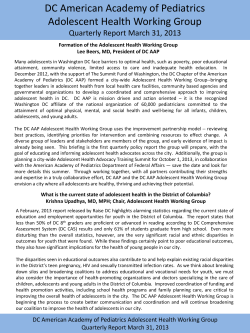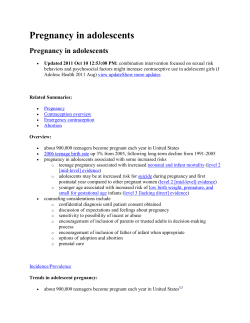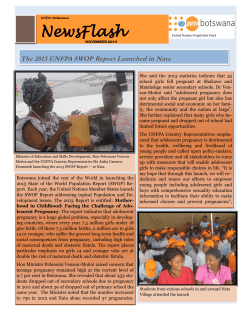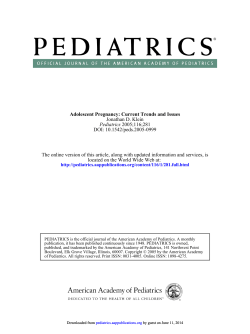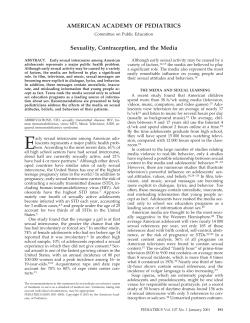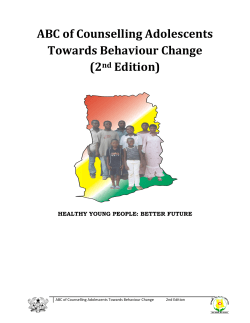
Perceived Facilitators and Barriers to Interventions Aimed at
Perceived Facilitators and Barriers to Interventions Aimed at Reducing Unintended Pregnancies among Adolescents in Low and Middle Income (Developing) Countries: a Systematic Review of Qualitative Evidence Yeetey Enuameh MD, MSc, DrPH 1 2* 3 1 ,Sarahlouise White BSc, MSc, PhD , George Adjei BSc, MSc, , 1 1 Livesy Abokyi BA, MPH , Seth Owusu-Agyei PhD , Professor Alan Pearson AM, RN, ONC, DipNEd, MSc, PhD, FRCNA, FCN, FAAG, FRCN 3 1. The Kintampo Health Research Centre Ghana: an Affiliate Centre of The Joanna Briggs Institute P. O. Box 200, Kintampo, Ghana. 2. Drexel University School of Public Health, Philadelphia, USA, 3. Joanna Briggs Institute, Faculty of Health Sciences, the University of Adelaide, SA 5005, Australia. * Corresponding author: yeetey@gmail.com Abstract Introduction Adolescent pregnancies are most often the result of sexual risk taking. Of the close to 14 million births among adolescents each year, between one-third and two-thirds are unplanned. Unplanned pregnancies coupled with societal restrictions result in adolescents opting for abortions under unsafe conditions. Objectives The objective of this review is to present the best available evidence on perceived facilitators and barriers to successful outcomes of programs aimed at reducing pregnancies among adolescents in low and middle-income countries. Methods Inclusion criteria Persons aged between 10 and 19 years residing in low and middle income countries, but during the review process, those up to 25 years, adults and opinion leaders were included. Search strategy Page 1 The search strategy aimed to find both published and unpublished studies using qualitative designs in English over the period of January 1960 to December 2010. Methodological quality assessment, data extraction and synthesis Critical appraisal of papers, data extraction and synthesis of findings were conducted using standardized tools from the Joanna Briggs Institute Qualitative Review Instrument. Results The review came up with 11 synthesized findings made up of 8 perceived barriers and 3 perceived facilitators. Conclusions Synthesized findings on both the barriers and facilitators encompassed adolescent, parental, community, health facility, care providers, school environment and societal contributing factors. Implications for practice Care providers should be respectful, ensure privacy and confidentiality to adolescents accessing contraceptive methods. Educational curricula should provide information on sexual and reproductive health. Adults should be educated on the importance of their roles and of a stable home in adolescents’ lives. Adolescents should be educated on contraceptives’ adverse effects and counselled on stigma associated with contraceptive use. Adolescent females should be encouraged to go to school and achieve their goals in life. Mothers and grandmothers should be educated on the benefits of female self-reliance. Health educators and care providers should provide information on sources of counselling and support for adolescents in need. Implications for research Further research should be conducted into the following: • Cultural/ societal norms perpetuating female subordination to males • Perception that [unprotected] sex is good for health and beauty • Misconceptions, myths and stigma associated with contraceptive use • Individual level factors that prevent early pregnancy among adolescents • Perceptions of love influencing sexual risk taking Keywords: Adolescent, teen, teenager, young people, youth, pregnancy, unintended Page 2 pregnancy Introduction One of the leading causes of death of female adolescents is pregnancy (mainly due to unsafe abortions and childbirth); females aged 15 -19 years are twice as likely to die during childbirth as compared to those in their twenties. (1, 4, 9) Birth rates have declined globally since the late 1980s among adolescents, but low and middle income countries (LMICs) have lagged behind the higher income countries (3) . The goal of the United Nations Millennium Development Goal (MDG) 5 is to improve Maternal Health (4) via a three quarters reduction in maternal mortality and achieving universal access to reproductive (4) health by 2015. Maternal health has on the whole improved, but maternal mortality remains high mainly due to adolescent deaths. aims at improving infant health. (4, 6) Improvements in MDG 5 are known to impact on MDG 4, which (4) Lack of family planning (FP) services results in about 17 million unintended pregnancies yearly in LMICs together with their complications. (6) Between a third and two-thirds of approximately 14 million adolescent births annually are unplanned. (9) Societal restriction could lead adolescents with unplanned pregnancies to go for unsafe abortions, which aside being a leading cause of maternal mortality, could result in permanent injuries to those undergoing such procedures. (6) Over a quarter of an estimated 20 million unsafe abortions performed globally each year are attributed to adolescents. (1) Pregnancies and labour in adolescence carry higher risks of anaemia, pre/-eclampsia, excessive bleeding, birth traumas (perineal tears, fistula, paralysis, etc.) and emotional trauma. adolescent death at childbirth, 15 to 30 others endure varying degrees of disability. (1) For each (1) Teenage mothers in most societies drop out of school and live in poverty- a vicious cycle in some communities. () Infants of teenage mothers could have lower birth weights, be anaemic from poor nutrition leading to them being at a higher risk of morbidity and mortality. (6) Infants without living mothers are ten times more likely to die prematurely compared to those with living mothers. (4) Consequences of adolescent pregnancies could result in health, educational, social, economic and psychological costs to societies across the globe. (1) Urgent efforts are required at reducing pregnancy rates among adolescents in LMICs as they contribute to high maternal mortality figures. Interventions that reduce adolescent sexual risk taking and pregnancies do not mitigate have socioeconomic, political, cultural and reproductive health benefits for individuals and society as a whole. (1, 12) Identifying perceived barriers and facilitators is important to improving current interventions and guiding future implementation efforts. Review objective The review’s objective was to present the best available evidence on perceived facilitators and Page 3 barriers to successful outcomes of programs aimed at reducing adolescent pregnancies in LMICs. Methods Inclusion criteria Studies included in the review were of persons aged 10 to 19 years living in LMICs qualitative study designs. Some other studies and opinion leaders (31) (25-30) (13) and of included persons up to 25 years of age, adults (31) . Search strategy The search strategy is detailed in an earlier publication (75) and aimed at finding published and unpublished studies related to the objectives of the review in English between January 1960 and December 2010. The time interval was chosen to identify relevant works in the area of adolescent sexual and reproductive health (ASRH) before and after the spurt in research in the area during the 1980s. (32) Assessment of methodological quality, data collection and data synthesis Details on methodological quality assessment, data extraction and data synthesis are found in an earlier publication (75) . Assessment for methodological quality, data extraction and synthesis were performed with the help of the Joanna Briggs Institute Qualitative Assessment and Review Instrument software (JBI-QARI). (33) Results Description of studies Most of the studies were from communities where some earlier interventions had been carried out. Studies mentioned interventions with multiple HIV and pregnancy prevention messages/ information and education campaigns (35) (25, 29, 34) , contraceptive availability and sexual health education in schools , community based distribution of contraceptives condoms (36) (30) , policies and laws to prevent early entry of adolescent females into sexual relationship and marriage (31) , adolescent friendly services, FP and HIV/AIDS control services Vijana (MkV) [Good things for Young People] program mentioned in study. (40) phenomenology (28, 38, 39) , ethnography narrative research method (38) Tanzania, two (39) (28, 29) (26, 27) (37) and MEMA kwa . Some studies and no interventions The methodologies of the studies were grounded theory (39) , (26-28, 36) (31) , , qualitative study , peer group method (34) (37) , descriptive cross- sectional study and no methodology stated Ten (10) studies were from sub-Saharan Africa, i.e. five Colombia , readily available oral contraceptives and (30, 31, 34, 37, 38) (25, 29, 30, 35) from Uganda, three . (25-27) from in South Africa and four from Latin America with one study each in Brazil , Ecuador (40) and Nicaragua. (35) (36) , The studies were done between 1997 and 2010, confirming the post-1980 (AIDS/HIV) era dramatic increase in research focused on the sexual and Page 4 reproductive health (SRH) of young people (32) . Perceived barriers Alienation of adolescents from health and educational facilities that are supposed to be helping them Adolescents feel a lack of privacy and confidentiality, with some providers being rude to them when they sought contraceptive services within health facilities. Together with their inherent fear of being treated disrespectfully, adolescents were hesitant in accessing FP services. Teachers in some schools were judgmental on SRH issues making it difficult for some adolescents to seek help from them. Inadequate adult supervision, care and guidance and effects of religious dogmas Adolescent females were unable to get from their parents, guardians and adults in the community the guidance, advice and appropriate information they needed. In place of advice, adults scared adolescents at times and adults avoided discussions on issues of sex. Some parents were not providing for the needs of their adolescent females. The influence of some religious dogmas resulted in some females being overly submissive and unable to assert themselves on issues including their SRH needs. Negative adolescent perceptions about contraception and fear of exposure by clinic records Some adolescents had the perception that contraception had serious adverse effects and the use of condoms was associated with a stigma of promiscuity, unfaithfulness. In the case of a partner suggesting condom use, it was perceived to be a tacit implication that either their partner or them were infected with HIV. Adolescents exercised the fear that clinic documentation such as contraceptive cards could expose them. Such situations could prevent adolescents from accessing FP services were they to be available to them. Sex as a conduit to health and resources Some adolescent females perceived unprotected sex as a means to good health and beauty. Some others saw sex as a means of making money off males; society incidentally viewed the exchange of money for sex as a principle of reciprocity. Perceptions such as these could enhance sexual risk taking and its many complications such as unwanted pregnancies. Societal abhorrence of open sexual discourse and adolescents use of FP services Information on sexual health cannot be openly delivered to adolescents for fear of corrupting them, and they are stigmatised for accessing contraception. Social norms that encourage adolescent females as subordinates to males Male dominance over females is endorsed by some societies, a situation that prevents females from being assertive and making independent decisions. Males are also seen as the sole decision makers on issues of FP and number of children born into the family. Females in some societies are seen as subordinates to males and to do everything to please their male counterparts. Girls who do not perform well academically view marriage as a way of maintaining their relevance in some of these societies. Page 5 Tacit personal and societal pressures on adolescents Adolescents endure indirect personal (immediate family, peers) and societal (norms and values) pressures to engage in sexual relationships and avoid pregnancy prevention measures. Adolescents are not included in state programs providing FP services and “B” messages are not clear and precise State FP programs were not willing to serve adolescents; and in instances “B” messages were ambiguous making them poorly understood influencing their uptake and utilization by young people. Perceived facilitators Having positive perceptions of FP practices and been assertive to protect themselves against unplanned pregnancies Assertive adolescents who know at which stage in a relationship to use a FP approach and have positive perceptions about FP are more likely to be protected against unwanted pregnancies. Care providers that address the needs of adolescents Adolescents expect care providers to have positive attributes such as being open and friendly, whilst addressing their needs in an environment of privacy and confidentiality. Such qualities attract adolescents to come for care. Protective attributes of the family and societal incentives Supportive families who provide for the needs of adolescents are more likely to protect them from unwanted pregnancies pregnancy, as do societal incentive packages aimed at keeping adolescents away from pregnancies. Discussion The review’s objective was to present the best available evidence on perceived facilitators and barriers to programs aimed at reducing pregnancies among adolescents in LMICs. Perceived barriers were identified in eight (8) synthesised findings, whereas facilitators were in three (3) synthesised findings of the review. Adolescents avoid health facilities where care providers are perceived as rude, unfriendly and (6, 28, 30) disrespectful. Young people are drawn to health facilities with a friendly approach to care delivery as amplified in their own words: "facilities that have a face of welcome". Adolescents are also drawn to care providers that address their needs, easily and effectively communicate with them providing information appropriate to their needs. (30) Adolescents are turned away by services that do not address their needs, care providers who are disrespectful and do not assure confidentiality and (31, 41) privacy. pregnancies. Education has been identified to keep young females away from sex and unintended (42) When adults are unable to provide for their needs (money, etc.), adolescents find them elsewhere including via sexual relationships. (31) Families that are supportive and care for the needs of adolescents and incentives from society could facilitate reductions in adolescent pregnancies. Page 6 (31, 35) Not all adults are able to perform their roles as guides and counsels for adolescents (28) in part due to poor knowledge of SRH issues, and a feeling of corrupting adolescents or society's non-acceptance of explicit sexual expressions. (28, 30, 35) Females’ capacity to independent decision on pregnancy prevention for example, is curtailed by some religious beliefs and dogmas that portray female as (35) subservient to males. Societal perception that condoms were for the promiscuous, created suspicions among partners (28-30, 37) (25, 37) (37) reduced trust in relationships (25) and as well as the fear of adverse events from contraceptive use prevented adolescents from accessing FP services. Adolescents were fearful that clinic records such as contraceptive cards could expose their use to those close to them. (38) Adolescents engaged in sex in exchange for money justified by its reactions (34) and other items, (34) which society somehow . Some adolescents felt unprotected sex made them healthy and beauty (27) exposing them to the risk of unintended pregnancies, and other health, educational, social, economic and psychological consequences. (1) Open sexual discourse was prohibited by society (27) sexually-corrupted contrary to empirical knowledge. excluded adolescents spoil them. (31) (31) on the presumption that adolescents would be (43, 44) State sponsored contraceptive programs as they were seen as too young to use them (35) and that their use would Adolescents therefore are unable to access contraceptive programs due to their fear of societal scorn and stigma (35) . Some societal norms make females subordinates and subservient to males, a phenomenon that society endorses tacitly. (30, 35) In some of these societies, early marriage of female adolescents is encouraged by their parents at the expense of their education the preserve of males (38) , older men go after young girls (35) (31) , decisions of contraceptive use are , and some mothers and grandmothers work assiduously to protect the status quo of male dominance over females (35) . These factors result in adolescent females literally outsourcing their decision-making rights to the males, making them vulnerable on issues like pregnancy prevention (27, 35, 38, 39) . Being unable to decide for themselves has other implications in that interventions targeting females could suffer some setbacks without the approval of their male counterparts. (35) Some adults pressured adolescents into sexual relationships for cultural and other reasons masculinity (27) (35) (31) , marital ; adolescents also pressured their peers to lose their virginity (31) (27, 34) , material (35) or prove their . There were other adolescents who knew about pregnancy prevention measures, but consciously avoided them to get pregnant or forgot to use them and got pregnant. (28, 35, 36) Such situations do not bode well for preventing unplanned births. Adolescents are increasingly becoming aware of the adverse effects of teenage pregnancies on their social development and adapting measures to protect themselves where necessary. (37, 38) There are those female adolescents who ensure that their male partners use contraceptives during any sexual encounter and would settle for nothing less. (37) Some males also noted they would prefer using contraception with their female partners who they trusted to prevent pregnancies. determination exhibited by such adolescents (37) (37) The level of self- could facilitate interventions aimed at reducing Page 7 unwanted pregnancies. Adolescents had different interpretations of the message on faithfulness and partner reduction. (45) Educational messages provided to adolescents should be simple and easy to assimilate them to prevent ambiguous interpretations (45) . Limitations of the review Efforts were made to systematically search for studies relevant to the review, however some could have been missed in the process. Also, studies included in the review were those published in the English language and within a particular time interval. Studies in other languages and beyond the date restrictions provided could have influenced in this review. Finally, studies excluded following the critical appraisal process may have contained relevant information but did not meet the methodological requirements set for the review. Conclusion The review generated 11 synthesised findings; 8 perceived barriers and 3 perceived facilitators describing adolescent, parental, community, health facility, care provider, school environment, family and societal factors. Implications for practice Care providers in health facilities and the community should be respectful, ensure privacy and confidentiality to adolescent clients who access contraceptive services. Program directors at the facility, district, regional and national levels of service delivery should periodically training care providers on making their services friendly and relevant to the needs of adolescents. Teachers should be trained on the SRH needs of adolescents and the need to accommodate their views instead of being judgmental. The educational curricula should also be age appropriate providing the necessary information on sexual and reproductive health of adolescents. Care providers and program directors should organise community meetings to sensitize the adult population on the importance of stable homes to adolescents and provide some guidance as to how to achieve this. Adults should also be educated on the importance of their roles as advisors, counsellors, guides in the lives of adolescents. Adults should be provided with avenues and resources where they could access information on the needs of adolescents. Adolescents should be educated on anticipated adverse effects of contraceptive use and what steps to take when they experience any such effects and counselled to assuage their fears with respect to stigma associate with contraceptive use. Care providers should also encourage adolescents to appear at clinics without their clinic records, in accordance with the principles of adolescent friendly health service (AFHS) delivery principles. Education should be provided to adolescents about the various risks of unprotected sex. Adolescents also require livelihood skills counselling to identify other sources of making money instead of seeing sex as a medium of gaining wealth. Page 8 There is the need for constant education and sensitization of society on the relevance of SRH education in improving the lives of adolescents. Health educators should present contraception and FP to the community as a means of protecting young people from SRH problems and serving as a means to a healthy and fruitful future. Adolescent females should be encouraged to see themselves as capable of attaining any heights, be encouraged to go to school and learn to the best of their abilities to achieve their goals in life. Mothers and grandmothers should be educated on the benefits of the adolescent female being self-reliant and the impact that would have on society as a whole. In dealing with issues of love, relationships and sexual risk taking among adolescents, de la Cuesta and colleagues (39) pointed out the fact that at the moment of taking critical decisions with respect to sexual relations with persons they loved, adolescent females had no experts to turn to. Adolescents require education on the need to identify pressures in the lives and how to respond adequately to them. Health educators and care providers should provide the necessary information on sources of counselling and trusted persons in society to adolescents to whom they can call for advice in times of distress and need. Measures should be in place to educate and enhance their skills to overcome vulnerability and assert themselves. Finally, the AFHS concept introduced by the World Health Organisation (WHO) and its partners, aimed at providing accessible health care to the adolescent population, could be used to guide care delivery and address problems related to reducing pregnancy among adolescents (2, 46) . AFHS, as an approach, involves all stakeholders ensuring that adolescents are provided the required and ageappropriate care to enhance their development. Implications for research Cultural norms that lead to female subordination to males cut across boundaries in the developing world. Addressing such norms go beyond one set of programs or interventions; much more research work, both primary and secondary, should be encouraged to address this issue. The perception among some adolescents that good sex provides good health needs some further research into such claims. Misconceptions, myths and stigma associated with contraceptive use influence pregnancy prevention programmes, and much more research is required to address these issues as they affect the health of not only adolescents but the whole population. As individual determination facilitates intervention success, further research could be conducted into individual level factors that prevent early pregnancy among adolescents in developing countries. de la Cuesta et al., 2001 (39) raised the issue of perceptions of love influencing sexual risk taking among adolescents. This is an area that requires much more research due to its subjective nature and its potential to throw some more light onto some of the driving forces behind adolescent sexual relationships. Page 9 Conflict of Interest None Acknowledgements This review was supported by a World Health Organization (WHO) grant with project no. HQHSR1003602 and a technical support agreement (TSA) no. 200349928 Page 10 Bibliography 1. United Nations Population Fund (UNFPA). State of the World Population 2003, Making I billion Count: Investing in Adolescents’ Health and Rights. Geneva: 2003. 2. World Health Organization (WHO). Adolescent Friendly Health Services: An agenda for change. Geneva: World Health Organization, 2002. 3. Macro International Inc. HIV/AIDS Survey Indicators Database [database on the Internet]. 2008 [cited March 18, 2008]. Available from: http://www.measuredhs.com/hivdata/. 4. United Nations (UN). Millennium Development Goals, Fact Sheet. 2010. 5. UN. Millennium Development Goals. 2010. 6. UNPPA. State of the World Population 2005: The Promise of Equality, Gender Equity, Reproductive Health and the Millennium Development Goals. New York: 2005. 7. Center for Disease Control (CDC). Unintended Pregnancy Prevention. 2012; Available from: http://www.cdc.gov/reproductivehealth/UnintendedPregnancy/index.htm. 8. Santelli J, Rochat, R., Hatfield-Timajchy, K., Gilbert, B.C., Curtis, K., Hirsch, J.S., Schieve, L., & the Unintended Pregnancy Working Group. The Measurement and Meaning of Unintended Pregnancy. Perspectives on Sexual and Reproductive Health. 2003;35(2):94-101. 9. WHO. Preparing for Adulthood: Adolescent Sexual and Reproductive Health. Geneva: 2003. 10. Singh S. Adolescent Childbearing in Developing Countries: A Global Review. Adolescent Reproductive Behaviour in the Developing World. Stud Fam Plann. 1998;29(2):117-36. 11. Committee on Adolescents. Contraception and Adolescents. Pediatrics 2007;120:1135-48. 12. Lugalla J, Emmelin, M., Mutembei, A., Sima, M., Kwesigabo, G., Killewo, J. & Dahlgren, L. Social, cultural and sexual behavioral determinants of observed decline in HIV infection trends: lessons from the Kagera Region, Tanzania. Social Science & Medicine. 2004;50:185-98. 13. World Bank (WB). How we classify countries. 2010; Available from: http://data.worldbank.org/about/country-classifications. 14. Johnson F, Lay, P. & Wilbrandt, M. Teenage pregnancy: issues, interventions, and direction. Journal of the National Medical Association. 1988;80(2):145-52. 15. Spear HJ, & Lock, S. Qualitative research on adolescent pregnancy: a descriptive review and analysis. Journal of Pediatric Nursing. 2002;18(6):397-408. 16. Tsui AO, McDonald-Mosley, R. & Burke, A. E. Family planning and the burden of unintended pregnancies. Epidemiologic Reviews 2010;32(1):152-74. 17. Scher L, Maynard, R. & Stagner M. Interventions intended to reduce pregnancy-related outcomes among adolescents. Campbell Systematic Reviews 2006;12. 18. Pierre N. & Cox J. Teenage pregnancy prevention programs. Current Opinion on Pediatrics. 1997;9:310-6. 19. Thomas MH. Abstinence-based programs for prevention of adolescent pregnancies. A review. Journal of Adolescent Health. 2000;25:5-17. Page 11 20. Yen S, Saah, T. & Hillard, P. J. IUDs and adolescents- an under-utilized opportunity for pregnancy prevention. IUDs and adolescents- an under-utilized opportunity for pregnancy prevention. 2010;23:123-8. 21. DiCenso A, Guyatt, G., Willan, A. & Griffith, L. Interventions to reduce unintended pregnancies among adolescents: systematic review of randomised controlled trials. BMJ. 2002;324. 22. Oringanje C, Meremikwu, M. M., Eko, H., Esu, E., Meremikwu, A. & Ehiri JE. Interventions for preventing unintended pregnancies among adolescents (Review). Cochrane Database of Systematic Reviews 2009(4). 23. Franklin CC, J. Preventing adolescent pregnancy: a review of programs and practices. Social Work. 2000;27:188-95. 24. Frost JJ & Forest JD. Understanding the Impact of Effective Teenage Pregnancy Prevention Programs. Family Planning Perspectives. 1995;27(5):188-95. 25. Baumgartner JN Lugina H, Johnson L. & Nyamhanga T. "Being faithful" in a sexual relationship: perceptions of Tanzanian adolescents in the context of HIV and pregnancy prevention. AIDS CARE 2010;22(9):1153-8. 26. Plummer ML, Wamoyi, J., Nyalali, K., Mshana, G., Shigongo, Z.S., Ross, D.A. & Wight, D. Aborting and Suspending Pregnancy in Rural Tanzania: An Ethnography of Young People's Beliefs and Practices. Stud Fam Plann. 2008;39(4):281-92. 27. Wight D, Plummer, M. L., Mshana, G., Wamoyi, J., Shigongo, J. S. & Ross, D. A. Contradictory sexual norms and expectations for young people in rural Northern Tanzania. Soc Sci Med. 2006;62(4):987-97. 28. Mkhwanazi N. Understanding teenage pregnancy in a post-apartheid South African township. Culture Health & Sexuality. 2010;12(4):347-58. 29. O'Sullivan LF, Cooper-Serber E, Kubeka M, Harrison A. Body concepts: Beliefs about the body and efforts to prevent HIV and pregnancy among a sample of young adults in South Africa. International Journal of Sexual Health. 2007;19(2):69-80. 30. Flaherty A, Kipp, W. & Mehangye, I. “We want someone with a face of welcome”: Ugandan adolescents articulate their family planning needs and priorities. Tropical Doctor. 2005;35(1):4-7. 31. Sekiwunga R. & Whyte SR. Poor parenting: Teenagers’ views on adolescent pregnancies in Eastern Uganda. African Journal of Reproductive Health. 2009;13(4):113-27. 32. WHO. Global Consultation on Adolescent Friendly Health Services A Consensus Statement. Geneva: World Health Organization, 2001. 33. Joanna Briggs Institute (JBI). JBI Reviewers' Manual: Joanna Briggs Institute; 2011. 34. Bohmer L, Kirumira EK. Socio-economic context and the sexual behaviour of Ugandan out of school youth. Culture Health & Sexuality. 2000;2(3):269-85. 35. Berglund S, Liljestrand J, Marin FD, Salgado N, Zelaya E. The background of adolescent pregnancies in Nicaragua: A qualitative approach. Social Science & Medicine. 1997;44(1):1-12. Page 12 36. Goncalves H, Souza, A.D., Tavares, P.A., Cruz, S.H. & Behague, D.P. Contraceptive medicalisation, fear of infertility and teenage pregnancy in Brazil. Culture, Health and Sexuality. 2010;13(3):201-15. 37. Chacko S, Kipp, W., Laing, L. & Kabagambe, G. Knowledge of and Perceptions about Sexually Transmitted Diseases and Pregnancy: A Qualitative Study among Adolescent Students in Uganda. Journal of Health, Population and Nutrition. 2007;25(3):319-27. 38. Nyanzi S, Pool, R. & Kinsman, J. The negotiation of sexual relationships among school pupils in south-western Uganda. AIDS CARE. 2001;13(1):83-98. 39. de la Cuesta C. Taking Love Seriously: The Context of Adolescent Pregnancy in Colombia. . Journal of Transcultural Nursing. 2001;12(3):180-92. 40. Goicolea I. Adolescent pregnancies in the Amazon Basin of Ecuador: a rights and gender approach to adolescents' sexual and reproductive health. Global Health Action. 2010;3(10). 41. Haller DM, Sanci, L. A., Patton, G. C., & Sawyer, S. M. Toward Youth Friendly Services: A Survey of Young People in Primary Care. Journal of General Internal Medicine. 2007;22(6):775-81. 42. Ringheim K. & Gribble J. Improving the Reproductive Health of Sub-Saharan Africa’s Youth: A Route to Achieve the Millennium Development Goals. Population Reference Bureau (PRB), 2010. 43. Kohler P, Manhart, LE. & Lafferty, W E. Abstinence-only and Comprehensive Sex Education and the Initiation of Sexual Activity and Teen Pregnancy. Journal of Adolescent Health. 2008;42(344-351). 44. Starkman N & Rajani N. The Case for Comprehensive Sex Education. AIDS Patient Care and STDs. 2002;16(7):313-8. 45. Baumgartner JN, Lugina H, Johnson L, Nyamhanga T. Being faithful in a sexual relationship: perceptions of Tanzanian adolescents in the context of HIV and pregnancy prevention. Aids CarePsychological and Socio-Medical Aspects of Aids/Hiv. 2010;22(9):1153-8. 46. Institute of Medicine/ National Research Council (IOM/ NRC). Adolescent Health Services: Missed Opportunities. Washington DC: National Research Council/ Institute of Medicine (NRC/ IOM), 2008. 47. MacPhail C & Campbell C. I think condoms are good but, aai, I hate those things? Condom use among adolescents and young people in a Southern African township. Soc Sci Med. 2001;52(11):1613-27. 48. Maja TMM. Factors impacting on contraceptive use among youth in Northern Tshwane: Part 2. Health SA Gesondheid. 2007;12(1):39-47. 49. Mantell JE, Harrison A, Hoffman S, Smit JA, Stein ZA & Exner TM. The Mpondombili project: Preventing HIV/AIDS and unintended pregnancy among rural South African school-going adolescents. Reproductive Health Matters. 2006;14(28):113-22. 50. Richter MS & Mlambo GT. Perceptions of rural teenagers on teenage pregnancy. Health SA Gesondheid. 2005;10(2):61-9. 51. Silberschmidt M & Rasch V. Adolescent girls, illegal abortions and sugar-daddies in Dar es Salaam: vulnerable victims and active social agents. Soc Sci Med. 2001;52(12):1815-26. Page 13 52. Wood K & Jewkes R. Blood Blockages and Scolding Nurses: Barriers to Adolescent Contraceptive Use in South Africa. Reproductive Health Matters. 2006;14(27):109-18. 53. Bennett SE & Assefi NP. School-based teenage pregnancy prevention programs: a systematic review of randomized controlled trials. Journal of Adolescent Health. 2005;36(1):72-81. 54. Bingham CR & Miller BC. An Epidemic of Adolescent Pregnancy - Some Historical and Policy Considerations - Vinovskis,M. Journal of Marriage and the Family. 1989;51(4):1095-6. 55. Braine T. Adolescent pregnancy: a culturally complex issue. Bulletin of the World Health Organization. 2009;87(6):410-1. 56. Card J. Teen Pregnancy Prevention: Do Any Programs Work? Annual Review of Public Health. 1999;20(0163-7525, 0163-7525):257-85. 57. Cordasco F. An Epidemic of Adolescent Pregnancy - Some Historical and Policy Considerations Vinovskis,Ma. Annals of the American Academy of Political and Social Science. 1989;504:166-7. 58. DeRidder LM. Teenage Pregnancy: Etiology and Educational Interventions. Educational Psychology Review. 1993;5(1):87-107. 59. Fox HB, McManus AM, Limb SJ & Schlitt, JJ. Structuring Health Care Reform to Work for Adolescents. Washington, DC: 2008. 60. Fullerton D, Dickson R, Eastwood, AJ & Sheldon TA. Preventing unintended teenage pregnancies and reducing their adverse effects. Quality in Health Care. 1997;6:102-8. 61. Harden A, Oakley A, Brunton G. & Fletcher, A. Teenage pregnancy and social disadvantage: systematic review integrating controlled trials and qualitative studies. British Medical Journal. 2009;339(b4254). 62. Harris M & Allgood J. Adolescent pregnancy prevention: Choosing an effective program that fits. Children and Youth Services Review. 2009;31(12):1314-20. 63. Hindin M &Fatusi AO. Adolescent Sexual and Reproductive Health in Developing Countries: An Overview of Trends and Interventions. International Perspectives on Sexual and Reproductive Health. 2009;35(2):58-62. 64. Kirby D. Effective approaches to reducing adolescent unprotected sex, pregnancy, and childbearing. Journal of Sex Research. 2002;39(1):51-7. 65. Meade CS & Ickovics JR. Systematic review of sexual risk among pregnant and mothering teens in the USA: pregnancy as an opportunity for integrated prevention of STD and repeat pregnancy. Soc Sci Med. 2005;60:661-78. 66. Nitz K. Adolescent pregnancy prevention: a review of interventions and programs. Clinical Psychology Review. 1999;19(4):457-71. 67. Philliber S & Nolte K. Implementation Science: Promoting Science-Based Approaches to Prevent Teen Pregnancy. Prevention Science. 2008;9(3):166–77. 68. Rieger D. Adolescent Pregnancy Prevention - Primary, Secondary, and Tertiary. Jama-Journal of the American Medical Association. 1990;263(6):813-. Page 14 69. Robbins C, Kaplan HB & Martin SS. Antecedents of Pregnancy among Unmarried Adolescents. Journal of Marriage and the Family. 1985;47(3):567-83. 70. Saunders RB & Brown HN. Innovative collaboration to prevent repeated adolescent pregnancies. Nursing Connections. 1997;10(3):5-11. 71. Tadesse E & Nigussie S. Adolescent pregnancies in Addis Ababa. East African Medical Journal. 2000;77(8):431-4. 72. Vincent ML, Clearie AF & Schluchter MD. Reducing Adolescent Pregnancy through School and Community-Based Education. Jama-Journal of the American Medical Association. 1987;257(24):3382-6. 73. Weatherley RA, Perlman SB, Levine MH & Klerman LV. Comprehensive Programs for Pregnant Teenagers and Teenage Parents - How Successful Have They Been. Family Planning Perspectives. 1986;18(2):73-8. 74. Whaley AL. Preventing the high-risk sexual behavior of adolescents: focus on HIV/AIDS transmission, unintended pregnancy, or both? Journal of Adolescent Health. 1999;24:374-82. 75. Enuameh Y., White S., Adjei G., Abokyi L., Owusu-Agyei S. & Pearson A. Perceived Facilitators and Barriers to Interventions aimed at Reducing Unintended Pregnancy among Adolescents in Low and Middle Income (Developing) Countries: a Systematic Review of Qualitative Evidence. Joanna Briggs Library of Systematic Reviews, 2012; 10(52):3338-3413 Page 15
© Copyright 2025


